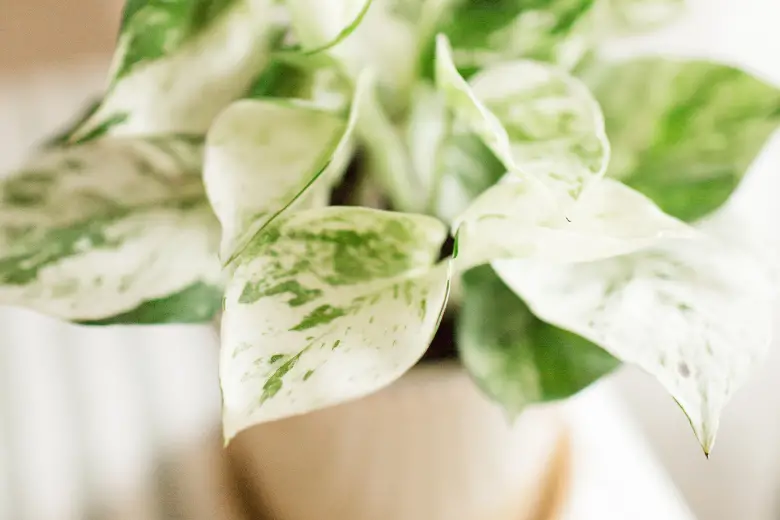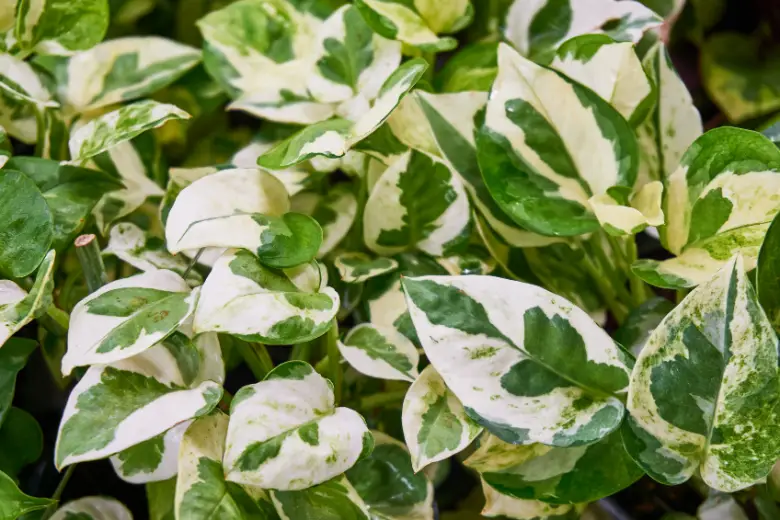We use affiliate links to run our site. When you buy through links on our site, we may earn an affiliate commission, without any added cost to you. Learn more
Have you ever looked at a lush, thriving Pothos plant and wished you had more of them in your home? Well, what if I told you that you can easily propagate your own Pothos plants, even if you’re a beginner gardener?
Propagating Pothos is a fun and rewarding way to expand your plant collection, and it’s not as difficult as you may think.
In this article, we will guide you through the entire propagation process, from understanding the different types of Pothos to selecting the right container and soil mix to choosing the best propagation technique.
We’ll cover everything you need to know to successfully propagate Pothos, including step-by-step guides for water propagation, soil propagation, and aerial root propagation.
We’ll also discuss aftercare, transplanting, and maintenance tips to ensure your propagated Pothos plants thrive and flourish.
So, whether you’re a seasoned gardener looking to try a new technique or a beginner wanting to dip your toes into the world of plant propagation, this article is for you. Get ready to learn how to propagate Pothos and add some greenery and beauty to your home!
What is Pothos?
Pothos, scientifically known as Epipremnum aureum, is a fast-growing vine that can thrive in a wide range of lighting conditions, from bright indirect light to low-light areas.
Its leaves are glossy, heart-shaped, and can grow up to 30 inches in length. Pothos is known for its air-purifying qualities, and it can remove toxins from the air, making it a popular choice for indoor spaces.
Why Propagate Pothos?
Propagating Pothos is an affordable way to increase your plant collection or share your favorite plant with friends and family. Additionally, propagating Pothos can help you rejuvenate an older plant or replace an unhealthy one.
Overview of the Propagation Process
Propagation is the process of creating a new plant from a parent plant. In the case of Pothos, this can be done through water, soil, or aerial root propagation.
Each technique has its advantages and disadvantages, and the choice will depend on your preferences and the condition of the parent plant.
Preparing for Propagation
Before propagating Pothos, it is essential to gather all the necessary tools and materials, including pruning shears, a clean knife, a rooting hormone (optional), a container, soil mix or water, and a support structure for aerial root propagation.
Understanding the Different Types of Pothos

There are several types of Pothos, including the classic green and yellow variegated variety, the neon variety with bright green leaves, and the satin variety with glossy, silver-green leaves.
Understanding the differences between the types can help you choose the right one for your propagation needs.
Choosing the Right Container
When propagating Pothos in soil, it is essential to choose a container that is slightly larger than the parent plant’s root ball. The container should have drainage holes to prevent waterlogging.
Selecting the Best Soil Mix
The ideal soil mix for Pothos propagation should be well-draining and contain a mix of peat moss, perlite, and vermiculite.
Gathering the Necessary Tools and Materials
Apart from the container and soil mix, you will need pruning shears, a clean knife, a rooting hormone (optional), and a support structure for aerial root propagation.
Propagation Techniques
Water Propagation
Water propagation is a popular and straightforward method of propagating Pothos. To propagate Pothos in water, follow these steps:
Step-by-Step Guide
- Cut a healthy vine just below a node, leaving at least two leaves on the stem.
- Remove any leaves near the bottom of the stem.
- Place the stem in a container of water, ensuring that the node is submerged.
- Change the water every week to maintain optimal conditions.
Maintaining Optimal Water Conditions
When propagating Pothos in water, it is essential to maintain optimal conditions, including a consistent water level, adequate lighting, and a warm temperature.
Common Mistakes to Avoid
- Overwatering: Too much water can cause the roots to rot.
- Underwatering: Insufficient water can cause the cutting to dry out and die.
- Direct sunlight: Direct sunlight can harm the cutting and prevent root growth.
Soil Propagation
Soil propagation is another popular method of propagating Pothos. Here’s a step-by-step guide on how to propagate Pothos in soil:
Step-by-Step Guide:
- Take a healthy stem cutting from your Pothos plant. Make sure it has at least two leaves and a few nodes.
- Fill a container with a well-draining soil mix. The soil should be moist but not soggy.
- Remove the leaves from the bottom node of the cutting. This is where the roots will start to grow.
- Make a small hole in the soil and place the cutting in the hole, making sure that the bottom node is fully covered.
- Cover the container with a plastic bag to create a humid environment.
Creating a Humid Environment:
To ensure successful propagation, it’s essential to create a humid environment. Here are a few tips:
- Cover the container with a plastic bag to create a greenhouse effect.
- Mist the cutting with water every few days to maintain humidity.
- Place the container in a warm, well-lit area, away from direct sunlight.
Common Mistakes to Avoid:
- Overwatering: Too much water can cause the roots to rot.
- Underwatering: Insufficient water can cause the cutting to dry out and die.
- Direct sunlight: Direct sunlight can harm the cutting and prevent root growth.
Aerial Root Propagation
Another way to propagate pothos is through aerial root propagation. This method involves encouraging the plant to grow roots while still attached to the parent plant. Once the roots have formed, the new plant can be separated and potted.
Step-by-Step Guide
- Locate a healthy vine on the parent plant that has at least one visible aerial root.
- Using a sharp, clean pair of scissors or pruning shears, make a small cut in the vine directly below the aerial root. Be sure to make the cut at an angle.
- Take a small piece of damp sphagnum moss and wrap it around the cut part of the vine.
- Cover the moss with plastic wrap and secure it in place with a twist tie or rubber band.
- Keep the moss damp by misting it with water or by placing the entire setup in a plastic bag with a few drops of water.
- Wait for the roots to grow. This process can take several weeks to a few months, so be patient.
- Once the roots have formed, carefully remove the plastic wrap and moss from the vine.
- Using a clean pair of scissors or pruning shears, cut the vine just below the newly formed roots.
- Plant the new pothos in a pot with fresh soil.
Tying the Plant to the Support
While waiting for the aerial roots to form, it’s important to tie the vine to a support. This will help keep the plant stable and encourage the roots to grow.
Use soft string or twine to gently tie the vine to a stake or other support.
Common Mistakes to Avoid
One common mistake when propagating pothos through aerial root propagation is not keeping the moss damp enough. The moss should be damp but not waterlogged.
Another mistake is cutting the vine too close to the aerial root. This can damage the root and prevent it from growing properly.
It’s important to leave some space between the cut and the root to allow for proper growth.

Aftercare
Once your Pothos has successfully propagated, it is important to provide the necessary aftercare to ensure its growth and health.
This includes transplanting the propagated plant into a new container, maintaining optimal growth conditions, fertilizing and watering appropriately, and pruning and shaping the plant.
Additionally, it is important to monitor the plant for any potential issues, such as root rot, pests, and diseases.
Transplanting the Propagated Pothos
Transplanting the propagated Pothos involves carefully removing the plant from its current container and placing it into a larger one. This allows the plant to continue growing and thriving in a suitable environment.
When transplanting, it is important to use a well-draining soil mix and to ensure that the plant is positioned at the same depth as it was in its previous container.
Maintaining Optimal Growth Conditions
To maintain optimal growth conditions for your propagated Pothos, it is important to provide it with proper lighting, temperature, and humidity. Pothos prefer bright, indirect light and temperatures between 65-85°F (18-29°C).
They also benefit from moderate to high humidity levels, which can be achieved through the use of a humidifier or by placing a tray of water near the plant.
Fertilizing and Watering
Proper fertilization and watering are crucial for the growth and health of your propagated Pothos. Fertilize the plant every 2-3 months with a balanced, water-soluble fertilizer.
Water the plant when the top inch of soil feels dry, being careful not to overwater as this can lead to root rot.
Pruning and Shaping the Plant
Regular pruning and shaping of your Pothos plant can help promote healthy growth and maintain its overall appearance.
Prune any dead or yellowing leaves as well as any vines that are growing too long or are tangled. You can also shape the plant by pinching back the tips of the vines.
Troubleshooting Common Issues
Root rot, pests, and diseases are common issues that may arise when caring for your propagated Pothos. To avoid root rot, ensure that the plant is not overwatered and that it is placed in a well-draining container.
Common pests that may affect Pothos include spider mites and mealybugs, which can be treated with a solution of water and dish soap.
Diseases such as bacterial leaf spots can be avoided by ensuring that the plant is not overwatered and that it is placed in a location with good air circulation.
Root Rot
Root rot is a common issue that can occur when the Pothos plant is overwatered or placed in a container with poor drainage.
Symptoms of root rot include yellowing leaves and a foul odor coming from the soil. To treat root rot, remove the plant from the container and trim away any affected roots.
Repot the plant in a well-draining container with fresh soil mix and reduce watering.
Pests and Diseases
Spider mites and mealybugs are common pests that may affect Pothos. Spider mites can cause the leaves to become stippled and discolored, while mealybugs appear as white, cottony masses on the leaves and stem.
Diseases such as bacterial leaf spots can cause the leaves to develop yellow spots and eventually fall off.
To treat these issues, use a solution of water and dish soap to wash the plant or use an insecticidal soap or oil.
How long does it take to propagate Pothos?
The propagation time for Pothos can vary depending on the method used, but generally, it can take a few weeks to a few months to see root development and new growth.
How often should I water my propagated Pothos?
It is important to maintain moist soil or water conditions while propagating Pothos, but be careful not to overwater, as this can cause root rot. Check the soil or water regularly and water when the top layer feels dry.
Can I propagate Pothos in just water?
Yes, Pothos can be propagated in water, and it is one of the easiest methods. Be sure to change the water every few days to prevent bacteria growth and maintain optimal conditions for root development.
Can I propagate Pothos from a leaf?
Yes, Pothos can be propagated from a leaf cutting, but it is not the most reliable method. It is best to propagate from stem cuttings or root divisions for a higher success rate.
Conclusion:
As we come to the end of this article, I hope that you feel inspired and empowered to take on the exciting challenge of propagating your own Pothos plants. Not only is it a great way to expand your plant collection, but it can also be a rewarding and fulfilling hobby.
Remember, propagating Pothos is not as difficult as it may seem, especially when you have the right tools, knowledge, and techniques. By following the step-by-step guide we provided, you can successfully propagate Pothos and avoid common mistakes that could hinder its growth.
If you found this article helpful, I encourage you to share it with your friends and family who might also be interested in plant propagation. Spread the joy of gardening and help others grow their own green thumb!
And don’t forget to explore more articles on our site for helpful tips and advice on gardening and plant care. We are committed to providing you with high-quality, informative content that can help you take your gardening skills to the next level.
So go ahead, take action, and start propagating your own Pothos today. It’s a great way to connect with nature and add some beauty to your home.
Amazon and the Amazon logo are trademarks of Amazon.com, Inc, or its affiliates.

Hi there! My name is Prasenjit and I’m an avid gardener and someone who has grown a passion for growing plants. From my hands-on experience, I have learned what works and what doesn’t. Here I share everything I have learned.
